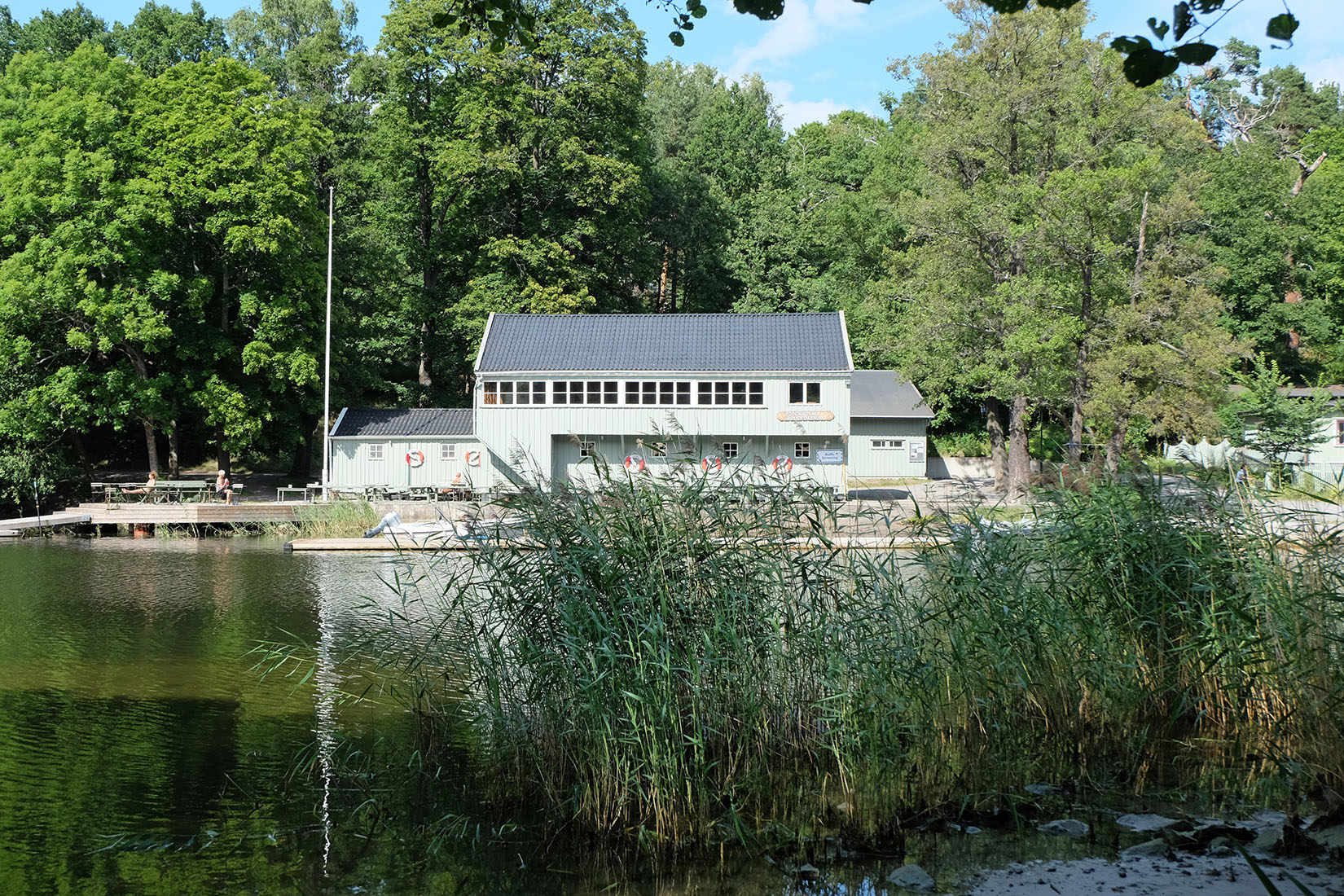 |
 |
 |
 |


Roddforenings Bathus (Boathouse for the Canoes of the City Rowing Club)
Djurgårdsbrunnsviken / Lidovägen, Stockholm
1912 - 1913
In 1912 Sigurd Lewerentz
and Torsten Stubelius were commisioned by the city rowing club to
design a boathouse for canoes. This commission was made on the occasion
of the Olympic Games in Stockholm. The boathouse was realized on a site
located by the channel, which separates the islet of Djurgården from
the mainland. This area is one of the most fascinating landscape spots
in Stockholm. The architects decided to use wood as construction
material, conforming with the traditional building type of the aera.
Their design has no similarities with the National Romantic Style,
which was prevailing at this time. Without special formal effects, the
wooden construction emphasizes the functional nature and simplicity of
the small building. The façades are clad with vertical wooden planks,
painted in a traditional green, the window frames are painted white.
The long horizontal strip window facing the channel, is considered to
be one of the main characteristics, and reflects the interior
arrangement of the building. The lower floor contains the storage space
for the canoes. The proportions of the building are determined by the
length of the canoes, which is between 10 and 18 meters. The upper
floor overhangs the lower one on the side facing the channel, creating
a protected area in front of the building. An small, covered staircase,
external to the main volume as in traditional houses, gives access to
this upper floor. Several of the rooms on the upper floor feature a
commanding view of the channel.
Im Jahr 1912 wurden Sigurd Lewerentz und Torsten Stubelius vom städtischen Ruderclub mit dem Entwurf für ein Bootshaus betraut. Der Auftrag wurde im Rahmen der Olympischen Spiele in Stockholm erteilt. Das Bootshaus wurde auf einem Grundstück an einem Kanal, welcher die Insel Djurgården vom Hauptland trennt, errichtet. Diese Gegend gehört zu den faszinierendsten Landschaften in Stockholm. Die Architekten entschieden sich für Holz als Baumaterial, übereinstimmend mit den traditionellen Gebäudetypen in dieser Gegend. Ihr Entwurf hat keine Ähnlichkeiten mit dem Nationalromantischen Stil, welcher zu diesem Zeitpunkt vorherrschend war. Ohne jegliche spezielle, formale Effekte betont die Holzkonstruktion die funktionale Natur und Einfachheit des kleinen Gebäudes. Die Fassaden sind mit vertikalen Brettern verkleidet, welche in einer traditionellen, grünen Farbe gehalten sind, während dem die Fenster weiss gestrichen sind. Das lange, horizontale Bandfenster auf der Kanalseite wird als eines der wichtigsten Merkmale dieses Gebäudes betrachtet, und widerspiegelt die innere Organisation des Gebäudes. Das untere Stockwerk enthält den Lagerraum für die Kanus. Die Proportionen des Gebäudes sind bestimmt von der Länge der Kanus, welche 10 bis 18 Meter beträgt. Das darüber liegende Geschoss kragt auf der Kanalseite etwas über das untere Geschoss hinaus, und bildet einen geschützten Bereich vor dem Gebäude. Eine kleine, gedeckte Treppe, wie bei traditionellen Häusern ausserhalb des Hauptbaukörpers angeordnet, ermöglicht den Zugang zum oberen Geschoss. Mehre Räume im oberen Stockwerk bieten eine eindrückliche Aussicht auf den Kanal.
Im Jahr 1912 wurden Sigurd Lewerentz und Torsten Stubelius vom städtischen Ruderclub mit dem Entwurf für ein Bootshaus betraut. Der Auftrag wurde im Rahmen der Olympischen Spiele in Stockholm erteilt. Das Bootshaus wurde auf einem Grundstück an einem Kanal, welcher die Insel Djurgården vom Hauptland trennt, errichtet. Diese Gegend gehört zu den faszinierendsten Landschaften in Stockholm. Die Architekten entschieden sich für Holz als Baumaterial, übereinstimmend mit den traditionellen Gebäudetypen in dieser Gegend. Ihr Entwurf hat keine Ähnlichkeiten mit dem Nationalromantischen Stil, welcher zu diesem Zeitpunkt vorherrschend war. Ohne jegliche spezielle, formale Effekte betont die Holzkonstruktion die funktionale Natur und Einfachheit des kleinen Gebäudes. Die Fassaden sind mit vertikalen Brettern verkleidet, welche in einer traditionellen, grünen Farbe gehalten sind, während dem die Fenster weiss gestrichen sind. Das lange, horizontale Bandfenster auf der Kanalseite wird als eines der wichtigsten Merkmale dieses Gebäudes betrachtet, und widerspiegelt die innere Organisation des Gebäudes. Das untere Stockwerk enthält den Lagerraum für die Kanus. Die Proportionen des Gebäudes sind bestimmt von der Länge der Kanus, welche 10 bis 18 Meter beträgt. Das darüber liegende Geschoss kragt auf der Kanalseite etwas über das untere Geschoss hinaus, und bildet einen geschützten Bereich vor dem Gebäude. Eine kleine, gedeckte Treppe, wie bei traditionellen Häusern ausserhalb des Hauptbaukörpers angeordnet, ermöglicht den Zugang zum oberen Geschoss. Mehre Räume im oberen Stockwerk bieten eine eindrückliche Aussicht auf den Kanal.